
Latino Economic Distress:
Recent Statistics
by Angelo Falcón (September 22, 2010)
The Census Bureau recently released disturbing statistics on poverty, income and health insurance coverage in the United State for 2009. This NiLP Latino Datanote updates some of these figures with Census information for 2010 from the same dataset, adds the most current related statistics from Puerto Rico (a territory of the United States), and presents some findings from the Census Bureau's new alternative poverty estimates it is developing. The purpose here is to further expand the empirical basis of the discussion on the growth in poverty as it affects the Latino community beyond what has so far appeared in the media on these issues.
Poverty and Unemployment in 2010
According to unpublished statistics from the March 2010 supplement to the Current Population Survey (CPS), the poverty rate for the United States in 2010 was 14.5 percent, representing over 44 million poor persons. For Latinos, the poverty rate was 25.4 percent, compared to 12.5 percent for Whites and Asians, 25.9 percent for Blacks and 27.7 percent for American Indians. The 12.4 million Latinos living in poverty make up 28.3 percent of the US poverty population, in comparison to 16 percent to the general population. None of these figures for 2010 include Puerto Rico (the poverty rate for Puerto Rico in 2008 was 46.0 percent; click here for the source of Puerto Rico statistics used in this report).
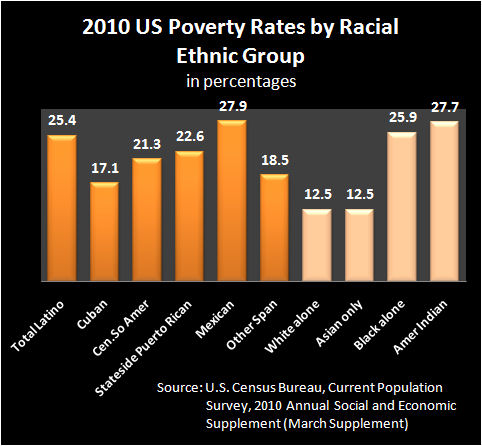
The poverty rate among Latinos varied for the different subgroups. Using the categories provided by the CPS, in 2010 Mexicans had the highest poverty rate among Latinos at 27.9 percent, followed by stateside Puerto Ricans (22.6 percent), Central and South Americans (21.3 percent), Cubans (17.1 percent), and Other Spanish (18.5 percent). Mexicans made up 71.8 percent of all the Latino poor.
According to the U.S. Bureau of Labor Statistics, in August 2010, Latinos had an unemployment rate of 12.0 percent. This compared to 8.7 percent unemployment for Whites and 16.3 percent for Blacks. The latest figure for Puerto Rico was for July 2010 when unemployment there stood at 16.9 percent.
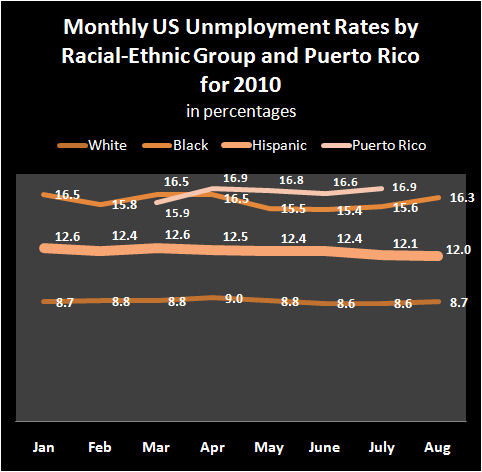
The Latino unemployed made up 18.3 percent to total unemployed stateside (excluding Puerto Rico). The unemployment rate among Latino men (20 years and older) was 10.2 percent, Latina women (20 years nd older) was 11.6 percent, and among Latino youth (both sexes, 16 to 19 years old) it was 33.0 percent.
Income, Poverty and Health Insurance 2008 and 2009
For a report just issued by the Census Bureau for 2009 on income, poverty and health insurance coverage, the headline was that they reported the highest poverty rate for the United States since 1994. These figures provide one of the first looks at the negative impacts of the recent economic recession.
The median household income for Latinos in 2009 was $38,039, 69.8 percent that of Whites. The median household income in 2009 for Whites was $54,461, for Asians it was $65,469 and for Blacks it was $32,584. In Puerto Rico, the latest figures available are for 2008, when the median household income there was $18,610, which was only 33.6 percent that of stateside Whites in that year.
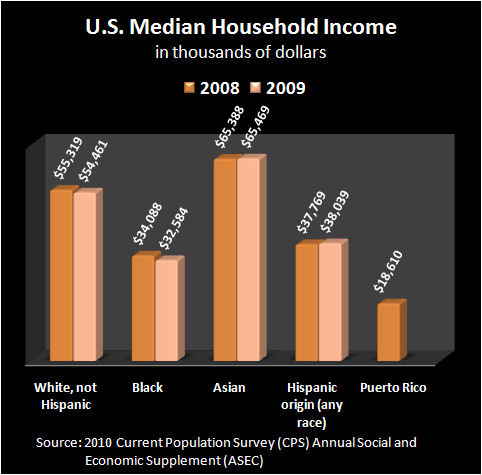
In 2009, stateside Latinos had a poverty rate of 25.3 percent, up from 23.2 percent the previous year. As we reported above, in 2010 it rose again very slightly to 25.4 percent. The Latino poverty figure is not statistically significantly different from that of Blacks, which was 25.8 percent, but considerably higher than that of Whites (9.4 percent) and Asians (12.5 percent).
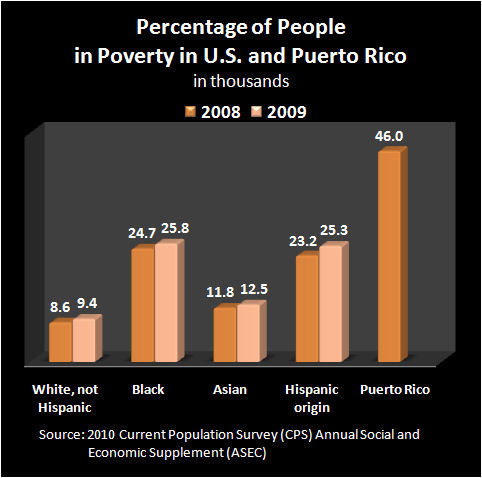
The poverty rate for stateside Latinos has increased from 22.8 percent in 1972, when these poverty statistics were first calculated for Latinos by the Census Bureau, to 25.4 percent in 2010. The high for Latinos in this period was in 1994, when their poverty rate reached 30.7 percent.
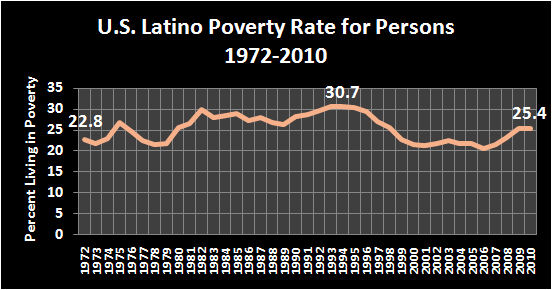
In 2009, Latinos continued to have the highest percentage of persons not covered by any health insurance. In that year, 32.4 percent of Latinos reported not having health insurance, compared to 21.0 percent of Blacks, 17.2 percent of Asians and 12.0 percent of Whites. In Puerto Rico, in sharp contrast, only 8.6 percent reported not having health insurance in 2008.
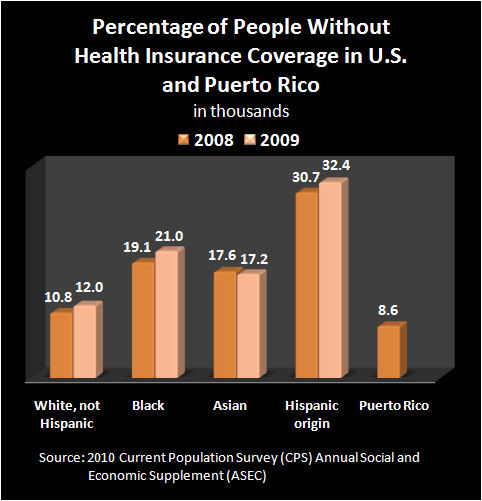
Alternative Poverty Estimates
Since the official U.S. poverty measure was first published in 1964, there has been continuing debate about alternative approaches to the measurement of poverty. Recognizing that alternative statistics can provide useful information, the Office of Management and Budget's Chief Statistician formed an Interagency Technical Working Group on Developing a Supplemental Poverty Measure charged with developing a set of initial starting points to permit the U.S. Census Bureau, in cooperation with the Bureau of Labor Statistics (BLS), to produce a Supplemental Poverty Measure (SPM). The new supplemental measure will be published initially in the fall of 2011 at the same time and level of detail as the 2010 income and poverty statistics that contain the official poverty measure, and annually thereafter.
The SPM will not replace the official poverty measure and has been designed as an experimental measure that defines thresholds and resources in a manner different from the official poverty measure. For details on the different adjusted estimates in the table below (MOOP, etc.), click here.
The Census Bureau will be releasing these alternative poverty estimates next year that factor in additional expenses and income, and adjust for geographical differences in cost of living. Applying these adjustments to the official poverty rate, the economic situation of Latinos appears consistently worse than for any other racial-ethnic group. Using these alternative measures for 2008, the Latino poverty rate ranged from 25.9 to a high of 31.8 percent. These figures do not include Puerto Rico.
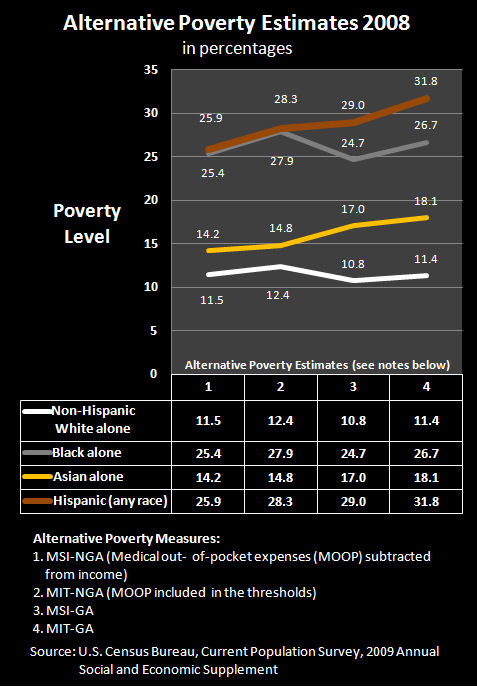
Angelo Falcón is President of the National Institute for Latino Policy (nILP). He can be reached at afalcon@latinopolicy.org. |